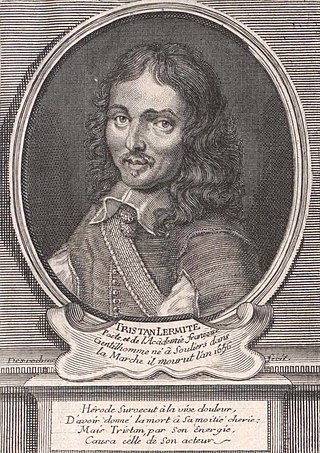
François l'Hermite was a French dramatist who wrote under the name Tristan l'Hermite. He was born at the Château de Soliers in the Haute Marche.
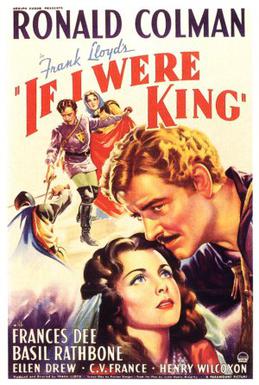
If I Were King is a 1938 American biographical and historical film starring Ronald Colman as medieval poet François Villon, and featuring Basil Rathbone and Frances Dee. It is based on the 1901 play and novel, both of the same name, by Justin Huntly McCarthy, and was directed by Frank Lloyd, with a screenplay adaptation by Preston Sturges.

The Archdiocese of Besançon is a Latin Church ecclesiastical territory or archdiocese of the Catholic Church in France. It comprises the département of Doubs and the département of Haute-Saône.

The Archdiocese of Reims or Rheims is a Latin Church ecclesiastic territory or archdiocese of the Catholic Church in France. Erected as a diocese around 250 by Sixtus of Reims, the diocese was elevated to an archdiocese around 750. The archbishop received the title "primate of Gallia Belgica" in 1089.
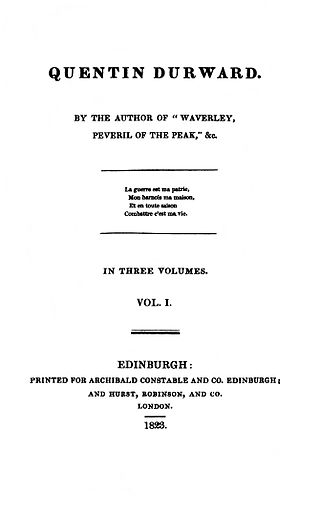
Quentin Durward is a historical novel by Sir Walter Scott, first published in 1823. The story concerns a Scottish archer in the service of the French King Louis XI (1423–1483) who plays a prominent part in the narrative.
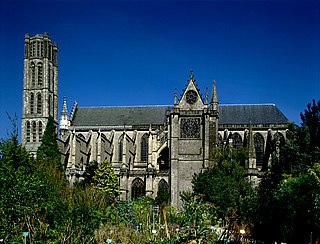
The Diocese of Limoges is a Latin Church diocese of the Catholic Church in France. The diocese comprises the départments of Haute-Vienne and Creuse. After the Concordat of 1801, the See of Limoges lost twenty-four parishes from the district of Nontron which were annexed to the Diocese of Périgueux, and forty-four from the district of Confolens, transferred to the Diocese of Angoulême; but until 1822 it included the entire ancient Diocese of Tulle, when the latter was reorganized.

The Adventures of Quentin Durward, known also as Quentin Durward, is a 1955 British historical film released by MGM. It was directed by Richard Thorpe and produced by Pandro S. Berman. The screenplay was by Robert Ardrey, adapted by George Froeschel from the 1823 novel Quentin Durward by Sir Walter Scott.
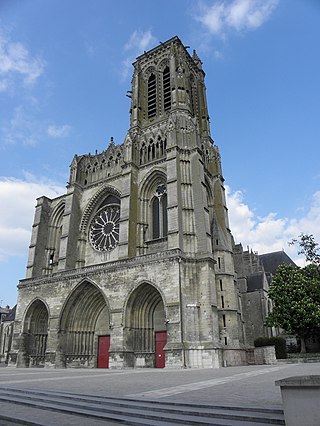
The Diocese of Soissons, Laon, and Saint-Quentin is a Latin Church diocese of the Catholic Church in France. The diocese is suffragan to the Archdiocese of Reims and corresponds, with the exception of two hamlets, to the entire Department of Aisne. The current bishop is Renauld Marie François Dupont de Dinechin, appointed on 30 October 2015. In the Diocese of Soissons there is one priest for every 4,648 Catholics.

The Vagabond King is a 1956 American musical film directed by Michael Curtiz and starring Kathryn Grayson, Rita Moreno, Sir Cedric Hardwicke, Walter Hampden, Leslie Nielsen, and Maltese singer Oreste Kirkop in his only feature film role. It was produced and distributed by Paramount Pictures. It is an adaptation of the 1925 operetta The Vagabond King by Rudolf Friml. Hampden plays King Louis XI. Mary Grant designed the film's costumes.
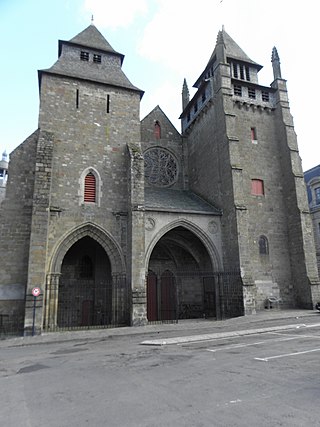
The Diocese of Saint-Brieuc and Tréguier is a Latin Church diocese of the Catholic Church in France. The diocese comprises the department of Côtes d'Armor in the Region of Brittany. The diocese is currently suffragan to the Archdiocese of Rennes, Dol, and Saint-Malo. The current bishop is Denis Moutel, appointed in 2010.

The Diocese of Arras (–Boulogne–Saint-Omer) is a Latin Church diocese of the Catholic Church in France. The episcopal see is the Arras Cathedral, in the city of Arras. The diocese encompasses all of the Department of Pas-de-Calais, in the Region of Hauts-de-France.
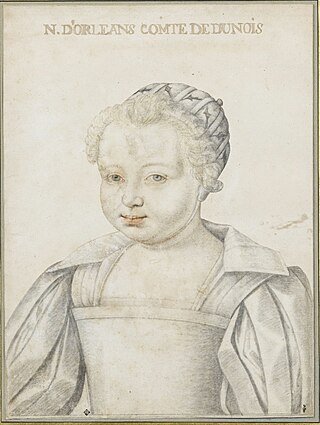
Monsieur d'Orléans was the second son and fourth child of Henry IV of France and his consort, Marie de' Medici. Commonly ascribed the names Nicolas or Nicolas Henri and the title Duke of Orléans, he was neither baptised nor invested as such during the course of his short life.
Molière's company was the theatrical company which formed around Molière from 1648 onwards, when he was performing in the French provinces after the failure of the Illustre Théâtre in 1645. In 1658 the company moved to Paris and, after a successful performance on 24 October 1658 in front of Louis XIV at the Louvre, was allowed to share the large hall in the Hôtel du Petit-Bourbon with the Italian players of Tiberio Fiorillo. At this time Molière's company became known as the Théâtre de Monsieur, since their official sponsor was the King's brother Philippe, Duke of Orléans, known as Monsieur. When the Petit Bourbon was demolished in 1660 to make way for the eastern expansion of the Louvre, Molière's troupe was allowed to use the abandoned Théâtre du Palais-Royal. The latter theatre had originally been built by Cardinal Richelieu in 1641. After Molière's death in 1673, his widow Armande Béjart and the actor La Grange kept the remnants of the company together, merging with the players from the Théâtre du Marais and moving to the Théâtre de Guénégaud. In 1680 the troupe of the Hôtel de Bourgogne joined the players at the Guénégaud, giving birth to the Comédie-Française.
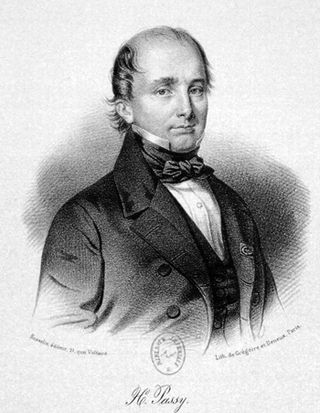
Hippolyte Philibert Passy was a French cavalry officer, economist and politician.

Louis-Guy de Guérapin de Vauréal, also Louis-Gui de Guérapin de Vauréal or Louis Guy Guerrapin de Vauréal, Baron de Vauréal et Comte de Belleval,, was a French aristocrat, ecclesiastic and diplomat.

Quentin Durward is a French-German swashbuckler TV series. It was produced in 1970, directed by Gilles Grangier and broadcast in 1971. The series starred the German actor Amadeus August as the protagonist and the French actress Marie-France Boyer as Isabelle de Croye. The series was based on Sir Walter Scott's in 1823 published novel Quentin Durward. It concerns a Scottish soldier who serves French King Louis XI (1423-1483) while the King has to overcome the schemes of his rival Charles the Bold and Jean Balue. The TV series kept close to the classic novel and was often shot at historic French locations. The French version consists of 7 instalments of 52 minutes each, while the dubbed German version had 13 episodes of about 25 minutes apiece. Both versions have been made available on DVD.

Jeanne de Coëme, Dame de Lucé and de Bonnétable was a French noble and courtier. She was the daughter of Louis de Coesme and a member of the House of Bourbon. She married François de Bourbon, titled the Prince of Conti. As such, after her marriage she was the Princess of Conti.

Gillot Saint-Evre was a French painter and engraver. He created scenes on historical and literary subjects, as well as genre scenes and portraits.

There are 10 church bells in the cathedral of Notre-Dame de Paris, all of which are mounted in the two main bell towers. Notre-Dame used to have other smaller bells in the spire and within the roof, but these were destroyed in a fire in 2019.

The Murder of the Bishop of Liège is an oil painting on canvas created in 1829 by the French artist Eugène Delacroix, showing the murder of Louis de Bourbon, Bishop of Liège by William I de La Marck's men during the 15th-century Wars of Liège, as told in chapter 22 of Walter Scott's historical novel Quentin Durward. First exhibited at the Paris Salon of 1831, it is now in the Louvre in Paris.



















